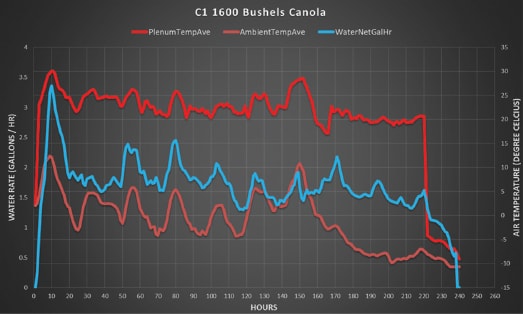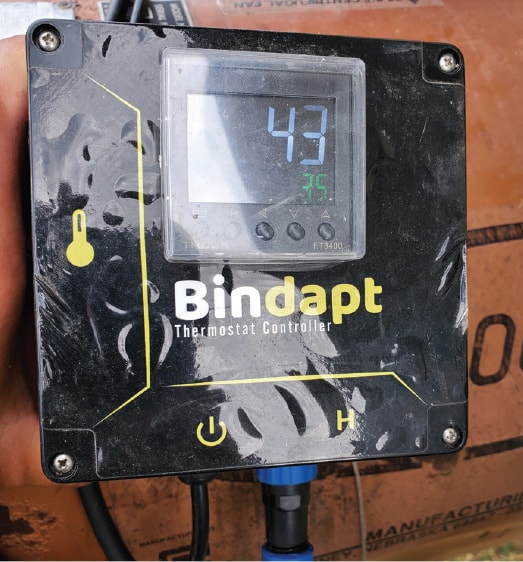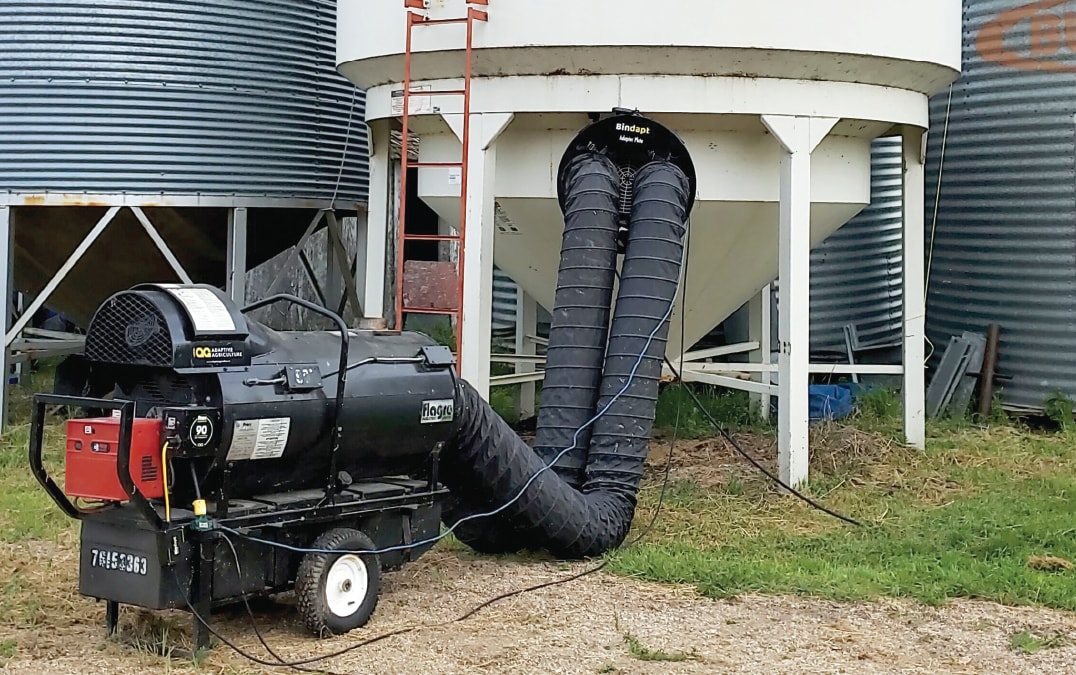How To Set Up For In-Bin Drying Of Canola
If Prairie farmers face another wet harvest, they’ll be left with a lot of damp and tough grain to deal with again. Many producers use natural air drying (NAD) systems, but cool fall air blown through a bin has very little capacity to dry tough grain. Adding supplemental heat will allow farmers to use their bins to remove moisture from their grain.
Key success factors for adding supplemental heat are airflow rates and the right temperature increase.
Airflow
“Airflow rate is the most important component of any in-bin drying,” says Glenn Wilde, engineer and director with Top Grade Ag.
Airflow is particularly important in canola because of its higher resistance, adds Angela Brackenreed, agronomy specialist with the Canola Council of Canada. “The smaller the grain, the smaller the voids between the grain, which means more resistance to airflow,” she explains.
Producers need to know their airflow to have predictable results, and Top Grade Ag offers an in-bin drying (IBD) monitor that provides three sensors. These sensors provide real-time data on air flow and water removal rates, bin average moisture content, heater status and fuel/power cost per hour, Wilde says.
| Fan Model | Commodity | Quantity (bushels) | Starting Moisture (%) | Final Moisture-Tested (%) | Running Time (days) | Average Airflow (CFM) | Airflow per Bushel (CFM) | Water Removed (ImpGal) | Average Removal Rate (ImpGal/hr) |
|---|---|---|---|---|---|---|---|---|---|
| GGI-80711 | Canola | 7360 | 11.5 | 9.1 | 7.7 | 4600 | 1.5 | 957 | 5.2 |
| GGI-80711 | Canola | 3687 | 11.6 | 8.2 | 7.4 | 4900 | 2.6 | 672.7 | 3.8 |
| GGI-80711 | Canola | 2000 | 12 | 11.2 | 1.9 | 4754 | 2.4 | 86 | 1.9 |
| GGI-80711 | Canola | 1400 | 12.4 | 5.7 | 3.7 | 4934 | 3.5 | 498.8 | 5.6 |
| GGF-80511 | Canola | 1000 | 11.3 | 9.3 | 1.5 | 2972 | 3 | 109.1 | 3.0 |
| GGF-80511 | Canola | 1810 | 11.8 | 8.9 | 4.9 | 2795 | 1.5 | 289.7 | 2.5 |
| GGF-80511 | Canola | 1050 | 12 | 8.2 | 2.5 | 3076 | 2.9 | 219.4 | 3.7 |
| GGF-80511 | Canola | 1570 | 15.6 | 7.1 | 8.9 | 2646 | 1.7 | 713.7 | 3.3 |
| GGF-80511 | Canola | 1440 | 15.8 | 9.9 | 6.3 | 2981 | 2.1 | 470.7 | 3.1 |
| GGI-80511 | Canola | 1440 | 11.3 | 9.3 | 2.5 | 3396 | 2.4 | 158.3 | 2.6 |
| GGI-80511 | Canola | 1140 | 12.2 | 9.9 | 2.1 | 3448 | 3 | 145.1 | 2.9 |
| GGI-80511 | Canola | 1650 | 12.3 | 9.3 | 4.9 | 2847 | 1.7 | 274.6 | 2.3 |
| GGI-80511 | Canola | 1450 | 12.6 | 10.1 | 2.8 | 3410 | 2.4 | 199.6 | 3.0 |
| GGI-80511 | Canola | 1120 | 15.7 | 7.4 | 6.7 | 3012 | 2.7 | 499.9 | 3.1 |
| GGI-80511 | Canola | 1650 | 16.2 | 9.4 | 9.4 | 3014 | 1.8 | 616.9 | 2.7 |
| ATT-80311 | Canola | 2400 | 11 | 9.1 | 3.8 | 3089 | 1.3 | 253.4 | 2.8 |
| ATT-80311 | Canola | 1500 | 15 | 8.5 | 9.7 | 3546 | 2.4 | 561.5 | 2.4 |
| GGI-80311 | Canola | 1000 | 12.1 | 7.7 | 4.3 | 2916 | 2.9 | 237 | 2.3 |
| GGI-80311 | Canola | 1600 | 13 | 8.3 | 10 | 2597 | 1.6 | 411.4 | 1.7 |
How hot?
Glenn Wilde warns that canola is prone to heating even if the moisture content is low, and that adding excessive heat makes it extremely important to ensure the bin is cooled down sufficiently after turning off the supplemental heat. Increased temperature also raises the risk of fire, he notes.
“With the correct temperature, your in-bin drying event should replicate field drying and maintain perfect quality,” Wilde says.
Angela Brackenreed adds that different temperatures have widely varying rates of moisture holding and removal. One cubic metre of 30°C air will hold 30 grams of moisture before reaching saturation, but 10°C air will hold only eight grams of water, she explains. And 18°C air removes moisture five times faster than 10°C air, Brackenreed notes.
Prairie Agricultural Machinery Institute (PAMI), which is currently working on a research project comparing drying systems in Alberta, urges farmers to maintain consistent air temperature flowing to the bin as much as possible. This can be achieved with thermostatic controllers.
In recently released trial results, PAMI reported a risk of overheating grain unless an adequate airflow rate – a minimum of one cubic food per minute per bushel (cfm/bu.) – can be ensured.

Fuel costs
Fuel type has the greatest impact on operating costs. Although natural gas is the least expensive fuel, Brackenreed notes most farms don’t have access to it. And although propane is often cheaper than diesel, diesel is very easy to use and everyone has diesel tanks on the farm,
she says.
Breaking down the costs for supplemental heat, Wilde says a standard system with natural gas would be close to two cents per point of moisture removed per bushel, while propane or diesel would cost closer to five cents.
An off-grid farmer he dealt with had all-in costs, including generating power with a diesel generator, of around eight cents per point per bushel.
He notes costs are dependent on factors like commodity prices, generator efficiency and IBD system efficiency.

IBD advantages and disadvantages
Advantages to IBD include adding value to bins with multifunction use, says Wilde. “It’s also a safe and effective method of drying and is easily scalable, not requiring hundreds of thousands of dollars to do. They’re also easy to get up and dismantle seasonally,” Wilde says.
PAMI says IBD has the potential to be a lower capital alternative to a stand alone dryer set up, but adds that careful management is required to keep operating costs comparable to that of a dedicated dryer system.
One drawback is that the IBD drying front can create a tough top and overdried bottom, Wilde says.
PAMI trials suggested that over-drying at the bottom of the bin may not be avoidable, and that an average dry moisture should be targeted and then the grain shouldbe mixed.
“It’s very hands-on,” agrees Brackenreed. “It’s not like we can add heat and then walk away from it.”
Another limitation is the system becomes less of an option once temperatures start falling below 0°C, she says.
“Airflow rateis the most important component of any in-bin drying.”
Setting up Bins
When designing an IBD system, Wilde says he first needs to define a monthly drying capacity based on the annual gross bushels harvested each year. “Using the monthly drying capacity, candidate bins are picked based on size, air delivery systems and the aeration fans available,” he explains.
Fans
Before upgrading air delivery systems in search of the “ideal” set up, Wilde strongly recommends installing an IBD monitor on your drying bins. “This allows you to evaluate the current performance, and gives you justification to make upgrades. It also allows you to evaluate any upgrade based on the before and after performance.”
Although he says any fan can be used for IBD applications, he says low-speed centrifugal is the better option for low static pressure. In his experience, axial fans are only good for very small batches.
Brackenreed adds: “There’s fans that produce high air flow, but that don’t operate at high static pressures. These are great for conditioning beans and corn, but will be useless when trying to condition canola.”
Brackenreed notes some farmers will under-fill bins to get better airflow results. She adds that a perforated floor on a flat-bottom bin typically allows for more even air distribution and less resistance to airflow.
“With portable heaters, there’s more opportunity for heat escape and heat loss, but they’re also convenient, often having multiple outlets, and can be moved from bin to bin.”
Ducting
Ducting is a huge item, and operators must be conscious of what their ducting is sized for, Wilde says. Brackenreed adds that ducting can affect resistance to airflow, and that poor ducting will create avenues for heat escape.
Venting
PAMI advises farmers to ensure adequate ventilation in the headspace as condensation on a cold bin roof can cause moisture problems in the stored grain. Brackenreed notes the rule of thumb of one square foot of ventilation for every 1,000 cfm of airflow.
Heaters
Providing enough BTUs to remove moisture is key to predictable and consistent drying, Wilde says. For a rough guide, use this formula to choose the right heater: Heater capacity (btu/hr) = temperature increase (degrees C) x air flow rate (cfm) x 2.05. For example, a target increase of 25°C multiplied by airflow of 2,500 cfm multiplied by 2.05 will require a heater capacity of 128,000 btu/hr.
Brackenreed notes that potential heat transfer loss can be as high as 50 per cent, but choosing a heater can go beyond simple energy efficiency. She explains: “With portable heaters, there’s more opportunity for heat escape and heat loss, but they’re also convenient, often having multiple outlets, and can be moved from bin to bin.”





